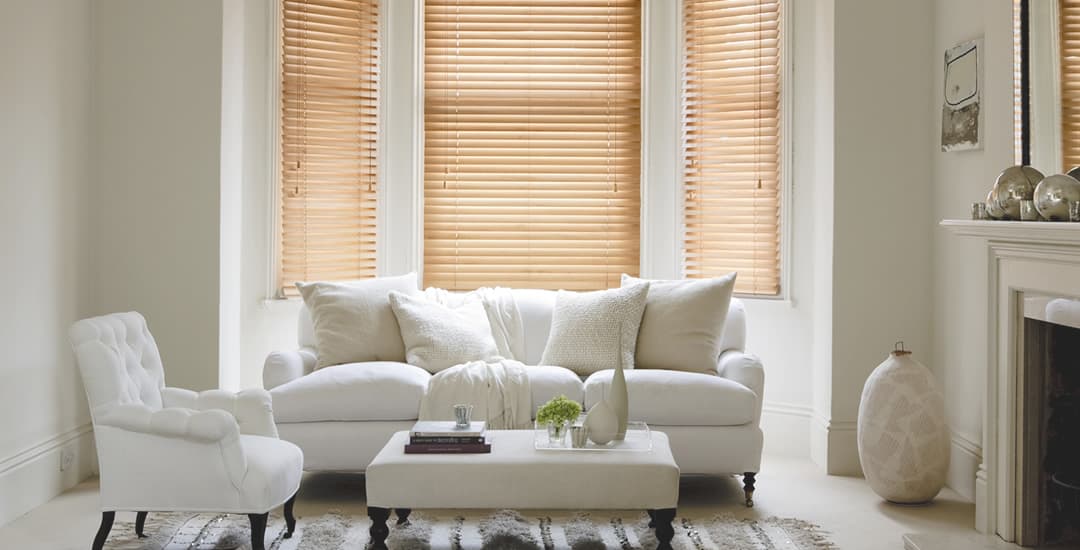
What blinds are best for living rooms, lounges, sitting rooms, or “the den” (depending on how fancy your upbringing was) depends on what sort of jobs your blind needs to be qualified to perform and anything weird or challenging about your living room and its windows.
Choosing living room blinds doesn’t come with the same sort of challenges that rooms like bathrooms and kitchens do, both of which can kill some polyester blinds stone-cold dead due to the presence of moisture in the air. However, you might want living room blinds to tick specific boxes, like helping to insulate the room or being able to filter light and so on, as well as showing off your impeccable taste and hawklike eye for quality.
Functional aspects aside, what type of blinds look best in living rooms and how they match the style and look of your living room is a Big Thing for most of us, as the living room is usually where we spend most of our at-home downtime, and also usually where we entertain visitors too.
In this blog post, I’m going to start by addressing the elephant in the (living) room, by which I mean tackling the “are blinds or curtains better in a living room” question.
I’ll then cover some of the most common living room challenges/traits that may affect or influence your choice of window blinds, and answer some of the questions we’re asked by people who are in the market for new blinds for the lounge too.
Contents:
- 1. Are blinds or curtains better in a living room?
- 2. What blinds are best for living rooms that need a bit of added insulation?
- 3. What blinds are best for living rooms that you can see straight into from outside?
- 4. What blinds are best for living rooms that get a lot of glare, or if I want to filter the light?
- 5. What kind of blinds are best for living rooms with bay windows?
- 6. What kind of blinds are best for living rooms that have very large or tall windows?
- 7. What blinds are best for living rooms with patio doors?
- 8. What blinds are best for living rooms with bifold doors?
- 9. What blinds are best for living rooms that are very plush and luxurious?
- 10. What kind of blinds are best for living rooms being decorated on a budget?
- 11. What kind of blinds are best for the living room if you have children?
- 12. Are living room window blinds child safe?
- 13. Can you have a roller blind in a living room?
- 14. Are there any types of blinds that you can’t use in a living room?
1. Are blinds or curtains better in a living room?
While the answer I want to give here is that “blinds are better than curtains, end of story,” I have to consider the possibility that this might simply be because I work for a blinds company and stand to gain absolutely nothing by swaying you in the direction of curtains.
That being the case and with my “objective” hat on, for 99% of you, neither option (blinds or curtains) is unfit for use in the living room, or by design, likely to be unviable for your window.
If that seems like a bit of an obvious statement, the point is that curtains won’t work full stop in some rooms like kitchens and bathrooms, as they can’t handle getting wet or picking up a lot of moisture from the air.
The 1% of you for whom all things may not be equal in the blinds or curtains stakes are those of you that have a walloping great radiator right under a window. Modern home builders, AMIRIGHT?
This is because if you use curtains in this scenario, the curtains will function as a sort of chimney to funnel all of the rising hot air up off the radiator, and point it at the window glass, where Outside will be only too happy to cool it back down again, costing you a fortune in heating bills only to ensure that you never actually get warm.
Another point to bear in mind is that if you want your living room window coverings to be able to filter light (as well as just blocking it when they’re closed) then you need blinds, as curtains still haven’t evolved far enough to possess this skill.
Setting aside then those couple of caveats, the choice between curtains or blinds for a lounge comes down to your preference on how they look, what you want them to do, and potentially, how much you want to spend, with blinds usually being like-for-like more economical than curtains of the same size and quality.
2. What blinds are best for living rooms that need a bit of added insulation?
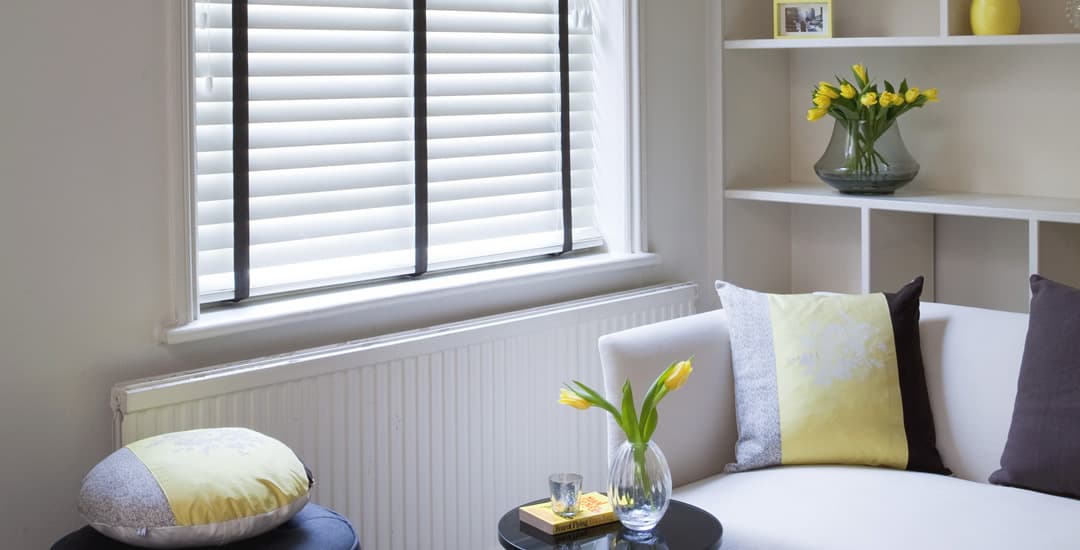
If your living room is on the cold side or costs a lot to heat, the window blinds you choose can potentially go a long way towards helping to keep the place comfortable without spending more than you need to on fuel.
This statement does rely on the issue being heat loss via the window(s) rather than poor insulation overall, but if your windows are single glazed, large, or otherwise the weak link in the insulation chain, blinds are your friend.
All types of window blinds insulate the window and so, prevent heat loss to some extent; curtains do too. But some types of window blinds are far more efficient at insulating than others, either due to the nature of the blind itself or because they’re made with an added thermally insulating blackout lining or coating.
It’s worth noting too, that while most people looking for living room blinds that help to insulate the room are trying to keep the heat they pay for in, insulating blinds are also a good choice for rooms that get very hot or overly bright in summer, as they also help to deflect sun and so, keep external heat out.
Either application means that the right blinds can make a noticeable, measurable change (in the right direction) to the temperature of the room compared to the outside temperature in both summer and winter.
So, what blinds are best for living rooms that get cold, lose a lot of heat from the windows, or get uncomfortably hot in summer?
- Perfect fit pleated blinds (also known as cellular blinds) offer perhaps the highest degree of insulation to the window, as they trap air in the honeycomb-style construction of their fabric. They are also fitted directly to the window itself, giving Cold Air or Hot Sun exactly zero chances to creep in around the sides of the blind.
- In terms of living room blinds that insulate really well simply because of what they’re made of, any type of faux-wood or real wooden blinds will do a grand job.
- Regular Roman blinds tend to perform pretty well as insulators too, as they are made of fairly heavy, thick fabrics.
- Some types of window blinds for living rooms encompass ranges of thermal blinds or can be made with a special thermally insulating blackout lining or coating as an option, and here your choices include roller blinds, vertical blinds, and Roman blinds.
- As mentioned, all types of blinds insulate the window they cover to a degree; but the least effective options for insulating a living room window would be Venetian blinds (the aluminium type) and day and night blinds.
3. What blinds are best for living rooms that you can see straight into from outside?
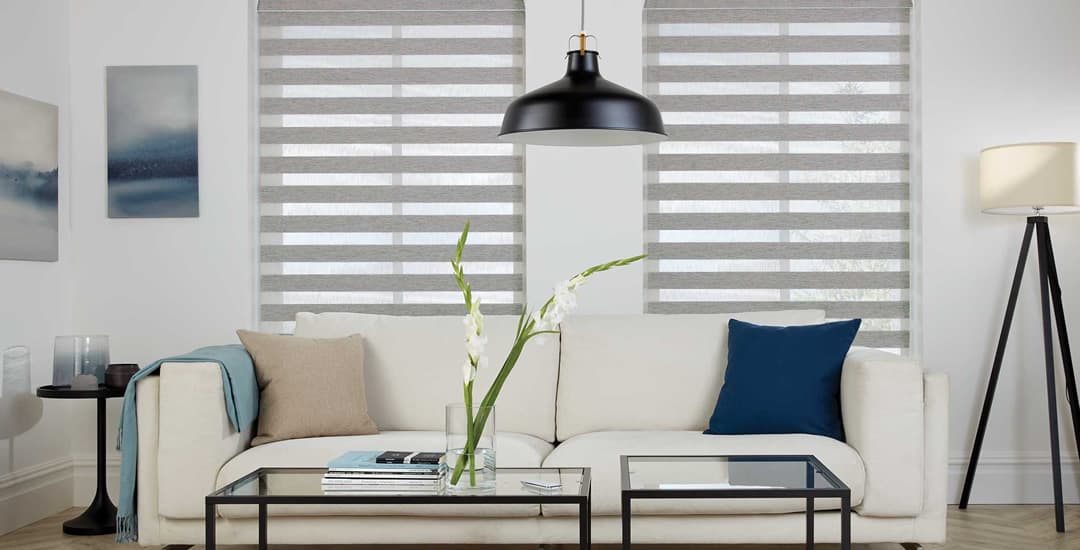
If your living room window opens directly onto a pavement or is similarly overlooked, then you’ll probably want to pick blinds that stop nosey parkers from learning more about the number of packets of crisps you eat when watching telly than you’re entirely comfortable with.
I actually had this specific problem in the lounge of a first floor flat that was right on top of a bus stop served by double deckers, so this potential challenge is not unique to ground floor living rooms either!
If your lounge window sees and is seen by a lot of randoms, you’ll probably want to choose blinds that offer privacy without turning the room dark; which gives you lots of choices of living room blinds but takes a couple off the table from the get-go too.
- Venetian blinds, real wood blinds, and faux-wood blinds all have slats that can be tilted with a fine degree of precision, to allow you to see out without making it easy for others to see in.
- Vertical blinds are excellent for controlling your privacy without the need to sit in the dark too, this time thanks to their adjustable louvres that can be tilted to any angle of your choosing. Vertical blinds provide perhaps the greatest degree of control in operation overall
- Day and night blinds or zebra blinds are new to the UK market, and totally unlike any of the other privacy control blinds mentioned so far. They’re made of a solid strip of fabric with alternating sheer and opaque stripes, and how you align said stripes allows you to enjoy the view without allowing “the view” to enjoy you right back.
Have a look at this introduction to day and night blinds for some more information on how they allow you to control your privacy without dimming the room. - Roman blinds and roller blinds are made of a solid piece of fabric that can’t be tilted or slanted; only opened or closed, which means that these aren’t a good choice for living rooms that are overlooked by passers-by.
4. What blinds are best for living rooms that get a lot of glare, or if I want to filter the light?
Few things will ruin your daytime gaming marathon or Netflix binge faster than screen glare from the sun. You can of course close the blinds fully and dim or black out the room as a whole, which you might want to do if you’re watching a horror movie or just want Outside and Reality and so on to go away.
But if you don’t want to spend the day sitting in the dark but do want to spend the day watching the telly without squinting, you want living room blinds that filter light. Conveniently, blinds that allow you to filter and control the light over and above the basic settings of “blind open/closed = sun on/off” are the exact same blinds I mentioned above that allow you to control your privacy without losing your entire view too.
- Basically then, Venetian blinds, faux-wood blinds, real wood blinds, vertical blinds, and day and night blinds will all let you filter the light to your living room and negate or deflect screen glare without turning the room overly dark.
- Dim out (or non-blackout) roller blinds are effective at filtering the light, although some fabrics can noticeably darken the room if they are a particularly thick and heavy weave.
- Roman blinds and blackout roller blinds can only darken the room entirely, and cannot be used to filter or diffuse the sunlight.
5. What kind of blinds are best for living rooms with bay windows?
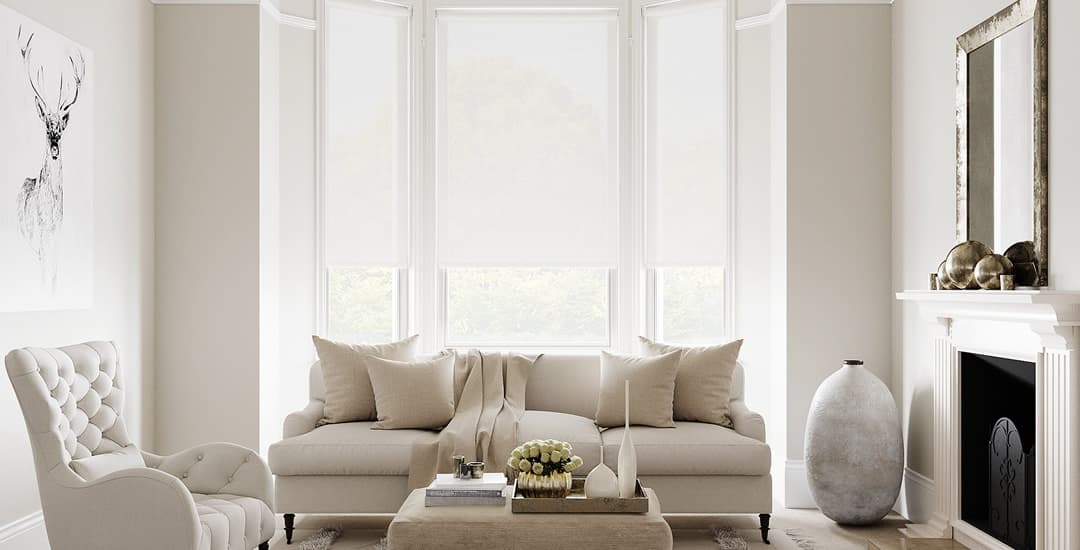
Getting your head around living room blinds for bay windows can be quite the learning curve, for reasons that are not always obvious at the outset! You have to factor in a number of things including the type of bay windows you have, the angle the windows meet at, and the propensity of said angle and various other factors to potentially cause gaps at the joins of the blinds.
Choosing the best living room blinds for bay windows can be a head-scratcher, and if you’re ready to start making your choices, I strongly suggest checking out my bay window blind guide before you order anything!
- For a basic steer to get you going, living room window blinds that will fit more or less any bay window are aluminium Venetian blinds or real wood blinds with 25mm slats (the narrowest slat option), pleated blinds, or Roman blinds.
- Most other types of blinds will fit most types of bay windows without issue; however, the width/protrusion of the headrail of some type of blinds can be problematic depending on the angle of the window’s corners, how narrow the window mullions are, and if the window has handles that stick out.
Seriously, read my guide, you can skip straight to the relevant part.
6. What kind of blinds are best for living rooms that have very large or tall windows?
If you have very large or tall windows in your home, they will almost certainly be in your living room; and the best blinds for living rooms with big windows need to take into account both the maximum size different types of blinds can be made in, and the challenges of hanging and operating a blind that weighs a lot.
In some cases, a really heavy blind or a really flimsy wall might mean that said blind doesn’t stay on said wall for very long in the first place, a problem in and of itself before you even consider the inherent risk of it taking someone out with it during its kamikaze descent to the carpet.
- If you’re working with a very tall or overall large window, sure-fire safe bets in terms of keeping the weight down and retaining ease of operation are vertical blinds, roller blinds, and day and night blinds.
- Aluminium Venetian blinds remain an option too for many big or tall windows, but do hit a threshold before rollers, day and night blinds, or verticals.
- The same tends to apply to Roman blinds; they can be made (and function smoothly) in big-ish or tall-ish sizes, but you won’t want to take a punt on them if the window in question is huge.
- Wooden and faux-wood blinds can become too heavy to hang/operate/remain safely attached to the wall over very tall or large windows, as well as difficult to make and ship in very large sizes in the first place.
This blog post on window blinds for tall windows can provide a bit more direction overall too.
7. What blinds are best for living rooms with patio doors?
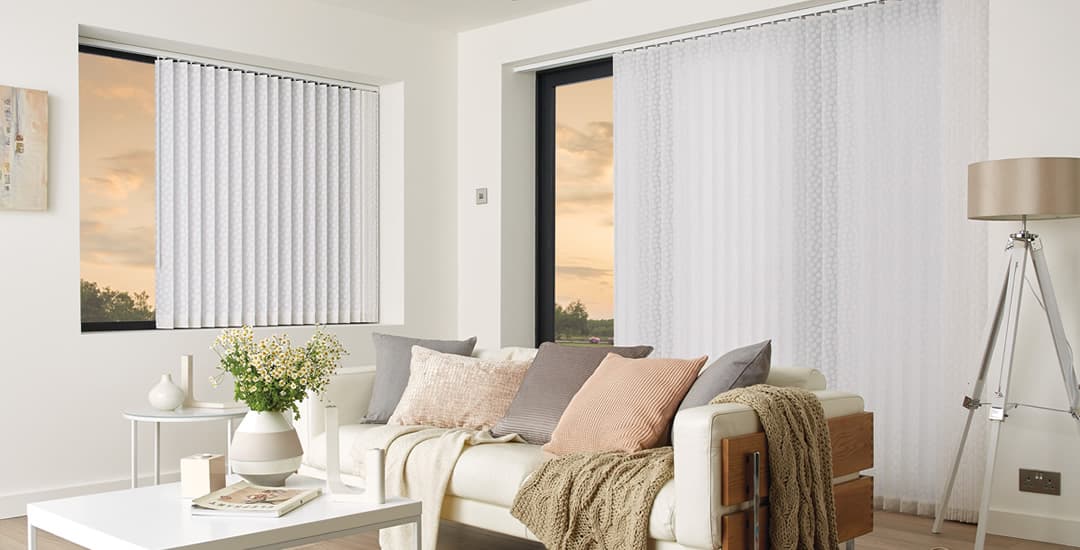
Choosing blinds for living rooms with patio doors means taking into account the same considerations as for large or tall windows, plus the fact that you need to be able to get to/out of the door part of the array as well.
- Overall, the best blinds for living rooms with patio doors are vertical blinds, because there aren’t really any caveats to note or limitations in place in terms of the width or drop they can be made in, nor functional considerations like weight and difficulty of operation when made in huge sizes.
- You may also be able to consider a roller blind as these aren’t overly weighty, or two roller blinds side by side, which also gives you the choice of having them in contrasting colours.
- Day and night blinds, which are a type of roller blinds, are a viable choice for living rooms as well as they too are not overly hefty.
- Venetian blinds are an option for most types of patio doors too (and for almost all patio doors if you abut two side by side rather than having one huge one) as they’re made of aluminium and so, are light weight.
- Window blinds that definitely won’t work on living room patio doors are wooden blinds and faux-wood blinds, due to the sizes they can realistically be made in and vitally, how much they weigh; this latter making them difficult to operate if very big. Also, when the blind is pulled all the way up the depth of the stack of slats could mean you might need to duck to get under them.
- Roman blinds too tend to be fairly heavy and so not usually suitable choice for patio doors. That said, depending on the fabric you choose, two side-by-side Roman blinds might work perfectly well as living room blinds on patio doors, but check with the retailer before you order! Another point to note is when the blinds are fully raised you may need to duck under the folds of fabric to get through the door.
8. What blinds are best for living rooms with bifold doors?
Living rooms with a row of bifold doors to outside can be a tricky proposition for window blinds, particularly if the doors themselves open into the room rather than outwards. So, what blinds are best for living rooms with bifold doors?
I wrote an absolute novel on the best blinds for bifold doors here, but now I’m looking to sum it up in as few words as possible, I’m not quite sure why…
- Perfect fit pleated blinds (also known as cellular blinds) are a universal choice, suiting nearly all types of bifold doors and being the only truly suitable option for bifold doors that open into the room.
- Other fully suitable options if your bifold doors open outwards include vertical blinds and roller blinds (the pros, cons, and considerations are once more covered in my bifold door blinds post) and there are a couple of other “may work” options mentioned there too for blinds for living rooms with bifold doors.
9. What blinds are best for living rooms that are very plush and luxurious?
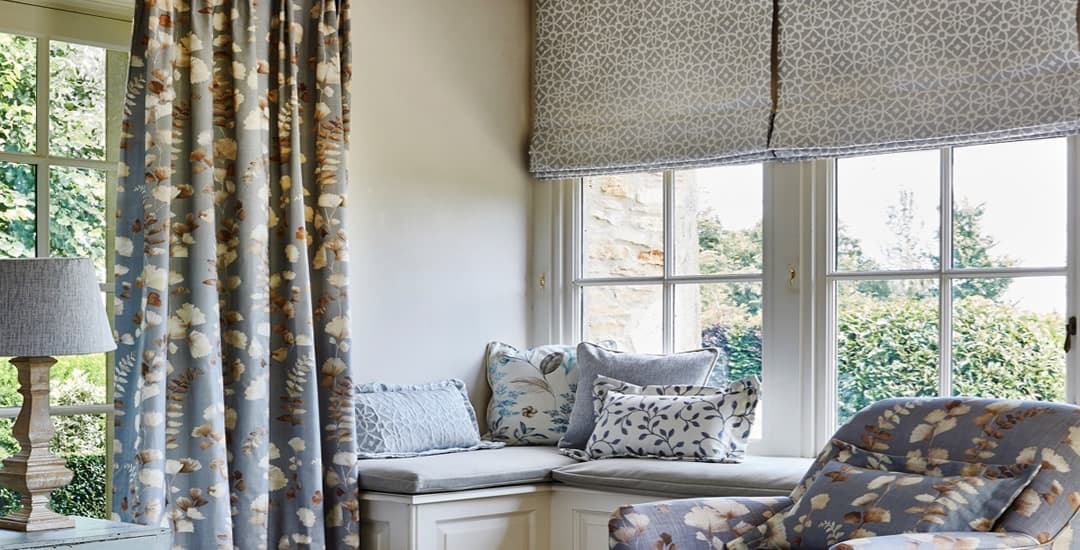
If your living room or general style preferences run to the high-end, whether your lounge is a huge space in a Grade II listed property or the focal point of your two-bedroom ex-council end of terrace, Roman blinds are absolutely the last word in chic living room blinds.
Roman blinds can be made in a huge range of different colour, pattern, and fabric choices, and some of these look fantastic in modern homes – they’re not just the preserve of those chasing a classical or traditional look – but they are always very plush-looking and have an undeniable aura of luxurious, genteel grandeur.
See also: the best blinds for living rooms if you want to make your friends jealous.
10. What kind of blinds are best for living rooms being decorated on a budget?
If you’re trying to keep costs down but also don’t want your living room to look naff, I have the sauce. So, what are the cheapest living room blinds?
- The first thing to note is that overall, the cheapest type of window blind to buy tends to be roller blinds, and Roman blinds are almost always the most expensive.
- Vertical blinds also tend to be an economical buy, and for large or tall windows, might even be a shade cheaper than roller blinds.
Also, have a look at my standalone blog post on what type of blinds are cheapest to buy; this lists the various blind types in order from most economical to the most “so we’re not eating this month.”
It will also point out a number of other things to help you to get the blind you want for the amount you want, such as that the price difference between blinds that are neighbours in the “cheapest” list is often negligible, and that there is sometimes overlap in this respect too.
It really is worth starting with the blinds you’d really, really like and running the numbers, in terms of putting your window measurements into the product page for said blind to find out immediately what it would set you back. You might be surprised in the good way, and even if not, you will get a clear picture of what you’re dealing with in terms of how far you need to manage your expectations from there.
11. What kind of blinds are best for the living room if you have children?
I don’t have children of my own and am in no way sad about this, but the key takeaway I have picked up from my BFF and her spawn is that having young children and nice things are often mutually exclusive.
Fortunately, said spawn is still at the age at which he can’t reach her living room blinds, and we’re all hoping that by the time this changes, he’ll have learned about not multitasking if one of those tasks is nose picking or finger painting, and the other is groping the living room blinds or trying to get to the window.
However, if your children are at or will soon reach the age/height that means they can both reach a window blind and would seek to either inadvertently or deliberately cause it harm, some window blinds are a far better choice than others.
I mean, for me, a good workaround here would be to not let the kids into the living room at all, perhaps using some kind of cage system for supervised introductions? If you don’t have room for a cage though, to summarise really quickly, here are some window blinds that are good for living rooms where kids hang out, and some to avoid.
- My top pick for living room window blinds if you have kids is faux-wood blinds. These tick all of the kid-related survival boxes, being overall the most hardwearing and sturdy type of window blind, being waterproof, and being really easy to wipe clean.
- Waterproof variants of vertical blinds or roller blinds are my second choice for living room blinds for families, as both of these types of blinds are reasonably inexpensive to buy, able to withstand the weekly orange squash throwing Olympics, and can be wiped clean.
They are not flimsy, but will not withstand prolonged, repeated head-on assaults with weapons, nor for verticals, a lot of grasping and pulling of the bottom chains and weights. - Roman blinds for living rooms that house kids are a terrible choice; Romans aren’t waterproof, tend to be high-end and pricey, and may be made of delicate fabrics.
- Day and night blinds too tend to be quite finely made in the sheer strips of their fabric, are fairly spendy compared to alternatives, and are not waterproof; so I’d say these are a no if you have kids and your living room blinds will be in reach of them/any projectiles they may launch.
- Wooden blinds too (real wooden blinds) are porous and so, prone to staining and becoming damaged by contact with liquids, and will potentially be damaged by kids who don’t know their own strength (or that you have angered, and that are intent on revenge).
- Venetian blinds, the aluminium kind, are kind of on-the-fence here, as they are waterproof and easy to clean, but if your child beats them about overly much, they will get dings, damage to the paintwork, and may become crooked and misshapen.
12. Are living room window blinds child safe?
I really do tend to think of window blinds and child safety in terms of keeping the blinds safe from the kids rather than the other way around, and traits like this are why I’m nobody’s first choice of babysitter.
However, for those of you that have or want them (kids I mean) keeping them from falling into the people mincer apparently takes up an inordinate amount of your time, and you wouldn’t want to have your attention split from stopping your child running with scissors in order to wonder if your window blind is perhaps going to end their flight first.
What type of living room window blinds are child safe then? All of them.
All window blinds sold in the UK/to the UK market have to meet the relevant child safety standards, which are largely designed to keep children from choking or hanging from the blind’s control cords. You can read more about modern window blinds and their child safety features in my prior blog post, and details on the relevant child safety standards our blinds meet/exceed are given on the product page for each blind too.
One final thing I need to point out here by the way is that window blinds need to be hung/fitted in accordance with the provided directions, such as the details covering the use of cleats, P-clips or breakaway devices (always supplied) in order to be child safe.
13. Can you have a roller blind in a living room?
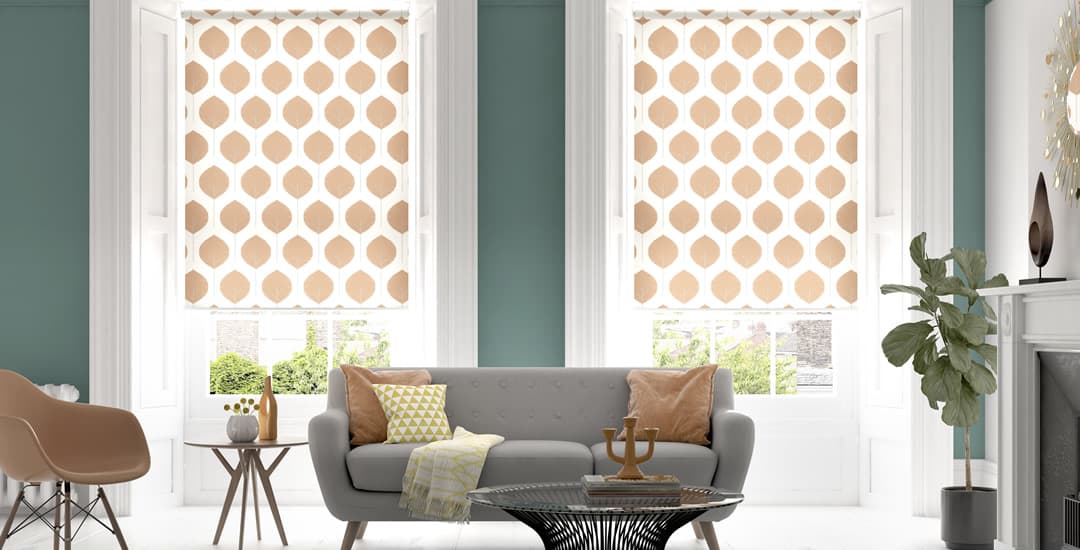
Yes, you can have roller blinds in living rooms; this oddly specific question about roller blinds rather than any other type of blinds somehow comes up a lot, perhaps because roller blinds are so popular overall or because they’re so ubiquitous in kitchens and bathrooms that people aren’t sure if they’re only really good for those types of applications.
Roller blinds for living rooms give you by far the widest range of choice in terms of the colours, patterns, designs, and finishes they can be made in, which along with their comparatively low cost, is a large part of their appeal.
14. Are there any types of blinds that you can’t use in a living room?
Now that I’ve comprehensively covered what blinds are best for living rooms of various different types, are there any blinds to avoid that I haven’t covered? The short answer to this is no, there is nothing about living rooms per se that makes any specific type of blind unsuitable for them, other than in terms of it clashing with the rest of the room’s style.
However, there are a couple of “but actually” points I just want to squeeze in here in closing, just as a sort of add-on to my mention of living room blinds that won’t work with kids.
These points are:
- If your living room is a total sun trap and gets the full glare of the sun for much of the day, fabrics within the room are going to fade faster than if your lounge is more or less a dungeon. Modern window blind fabrics (of all types) are treated with a UV-resistant finish to slow down the rate at which this happens, but it does happen; and so a really high-end set of Roman blinds with a colourful and intricate design might not look so good a few years down the line if they’re in a room that gets a lot of direct sun.
- Yellowing of white and light-coloured hard blinds (like faux wood) used to be an issue in this respect too, but the treatments used on them these days more or less negates the issue entirely, so acutely does it slow the process down.
- If you have a large/powerful radiator or other source of meaningful heat (open fire, solid fuels stove etc.) with a window above it or very close to it – first of all, literally anything will burn eventually if it gets hot enough, so pay close attention to the fire safety aspect in terms of the proximity of any type of blind.
- Mainly though, avoid using a faux-wood blind in very close proximity to (such as directly above) a radiator or heat source that kicks out a lot of heat, as prolonged or repeated exposure to temperatures over 50 degrees Celsius (to be clear, this is really, really hot and highly unlikely to be produced by anything that heats a real lounge) can cause them to warp.
Any questions about the best blinds for the living room? Ask in the comments or send me an email.




